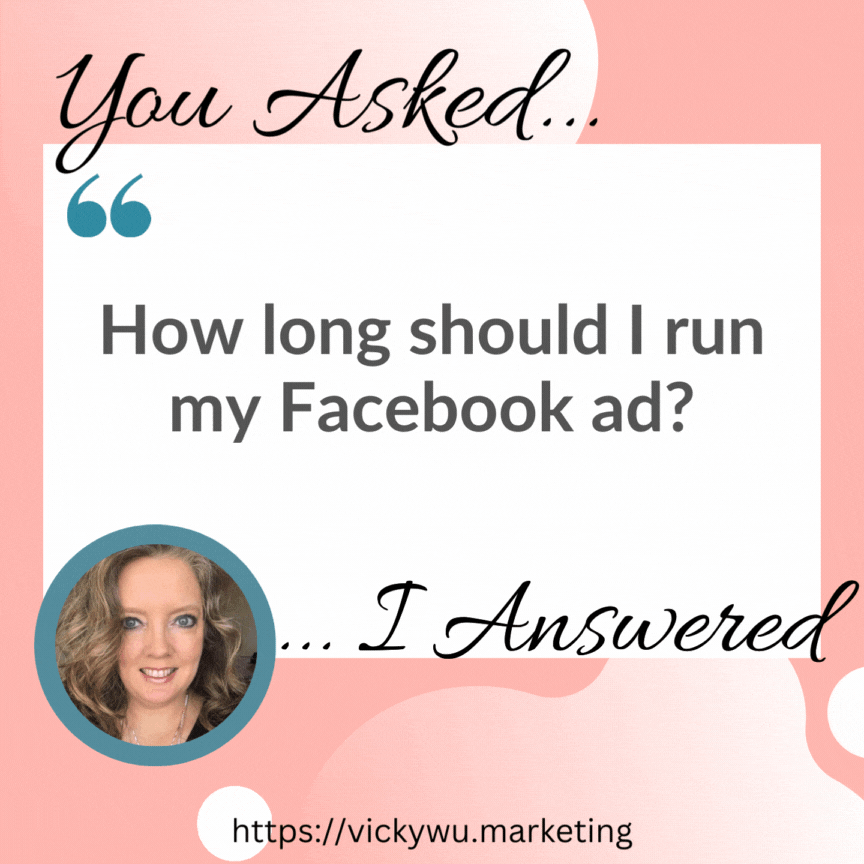- +1 512-591-8295
- [email protected]
- Mon - Fri: 9:00 - 16:00

Our CEO Vicky Wu brings her 30 years of experience marketing for Fortune 500 companies, multi-million and multi-billion-dollar global corporations to answer your specific marketing questions. Most entrepreneurs aren’t able to find – or afford – access to this level of expertise. And that’s exactly why we’re bringing it to you.

Sometimes I "boost" posts on my Facebook and run those for only a week or so. Sometimes I have an ad that I run for every day for a couple of months.
So I was wondering, how long should I run my Facebook ads? Is it better to run them only a few days, or should I schedule them more long term?Amy
Well, like everything with marketing – it depends. Your business isn’t cookie cutter, so my answer here can’t be either. Yet I do have a few guidelines – and a new way to think about your Facebook audience vs how long your ad is running.
TL;DR … a mix of short “boosts” plus longer running “ads” is often a winning combination. Here’s why:
Most entrepreneurs understand this to be that you’re spending ad money to have one particular post that you make to your business page get some extra traction. But how you accomplish that can vary.
Let me note first that I always recommend that you use Facebook Ad Manager even if what you’re doing is boosting one existing post. Yes, it’s tempting just to click that little button that shows up underneath a post urging you to boost it … they do that to make it easy for yo to spend money with them (and we all agree it’s always smart for a business to make it easy for you to spend money with them.)
But … you don’t have as fine of targeting selections when you do this; so I always recommend that you go through the Facebook ad system, and select the existing post there, so that you can have granular control over the audience that you’re targeting.
Whenever you’re “boosting a post” … make sure you do it the second way, and not the first.
Driving more attention to individual posts on your page definitely helps that post, and also helps your page overall.
When boosting a post like this, most entrepreneurs are doing so for only a short time frame, maybe a week or two at the most. Some of our clients in our integrated content marketing programs share new blog posts to their social media weekly, and then will boost that post (using the second method above!) to get it in front of as many people as possible, as quickly as possible. Yet the next week they have another new post, and don’t want the two to overlap – so the ad strategy is weekly ads that are different each week.
When you create an ad campaign in Facebook ad manager, you get a lot of fine control over the audience you are targeting. Not just demographics such as age, gender, and location, one of the most powerful aspects of this targeting is interests and behaviors (yes, even after Facebook took some of the options away).
Here’s a secret about your Facebook ad audience. I haven’t found exact documentation about this from Facebook directly, but this is what I have witnessed with the thousands and thousands of Facebook ad campaigns we have run.
So you’ve selected your audience, and it’s probably pretty big – hundreds of thousands to millions of people. And, if you know your audience at all – which is pretty important in business – included in that targeting will obviously be people who already like your page, or have seen or interacted with something from your page in the past even if they don’t follow your page. Right? Makes sense.
You’re likely also aware that Facebook ads go into a “learning phase” immediately after you publish. How quickly they exit the learning phase varies, but usually it’s within a few days. So for the first few days after your ad campaign starts, their algorithm is trying to figure out the most effective people to show it to, and during these couple of days your results and costs won’t be as effective.
But what happens after the learning phase? Are all audience prospects created equal?
No.
From the data we’ve gathered over the years and tons of campaigns, here’s what I think is most likely.
For about a week to 10 days or so – the exact timing will vary based upon a lot of factors – Facebook is first showing your ad to those people who are most likely to engage with the ad. Especially if your ad is using a cost per click basis, Facebook wants you spending ad money quicky, and the best way to do that is for clicks to happen. That’s actually a win-win.
They also know that it’s important for most entrepreneurs to start seeing results quickly, so what they’re doing during the time right after you’ve published your ad campaign and it’s exited learning phase is putting the ad in front of people most likely to engage – and in most cases, that’s the people included in that big audience of a million people you chose who are already connected with you in some way. This is the low hanging fruit.
We’ll call this a warm audience, or maybe lukewarm audience. People who have already liked your page, people who have liked or commented on a post at some point in the past but who haven’t yet liked your page, friends of those people … these are the groups who are getting served your ad first. And this makes sense, right? They’re more likely to click or interact.
It’s important for you to take your Facebook audience off the platform. I’ve said it again and again, and shared horror stories about what can happen when you’re relying upon a third-party platform. So taking your low-hanging fruit and getting them to engage with your ad is probably taking them deeper into your funnel, which is always a good thing.
Yet … most entrepreneurs are advertising to reach a bigger audience. Introduce new prospects to our business. Increase awareness among those who may never have heard about us yet. The audience that is not low-hanging fruit.
And this is where the magic of going more days into a campaign happens.
Your ad has run for a week or maybe two, and you’ve gotten good results thanks to that low-hanging fruit – efficient impressions and cost per. Then, the results start to drop off. Your cost per click starts rising a bit, and you’re getting fewer interactions.
This is the point at which most entrepreneurs will freak out and stop the ad. Yet you shouldn’t, because the system is working like it was intended. (Unless your results are abysmal and would make you go bankrupt – that’s a different discussion.)
Your ad has moved from your warm audience to a cold audience. These are people who are less likely to be aware of your business. We all know that it’s harder to get a new customer than it is to keep an existing customer. The same philosophy applies here – it’s going to be harder and cost slightly more to gain a new person interacting with an ad or following your page, than it is someone who already does.
But you need those new people, right? If all of our businesses were able to be wildly successful without having any new prospects drop into our funnel, you wouldn’t need marketing and you wouldn’t need me.
So, if your goal is to increase your overall pipeline of prospects, then you need to let your ads run longer. At some point, they will have run their course and need new creative, new images, new videos, new text … but for the most part they can run much longer than you probably even think after reading this information.
Remember that the average person still needs to see or hear your message 7 to 11 times before they even realize you exist. Having those long-running ad campaigns that allow the same message to get in front of the audience more than once is one of the best ways to make this occur.
A mix of short-term post “boosts” and longer-running ads is usually a great combination depending upon your overall goals. And we have further advice if your ads are getting clicks but not converting.
Vicky
Have a marketing question?
Click the chat bubble icon bottom right of the website and ask your question
– OR –
Leave a comment in the “Reply” section down below
Get solid marketing strategies, designed for entrepreneurs on the track to 7-figures and beyond, right in your inbox.

This website uses cookies to ensure you get the best experience on our website. By continuing to use the website, you agree to our use of cookies. We do not share or sell your information. More info
